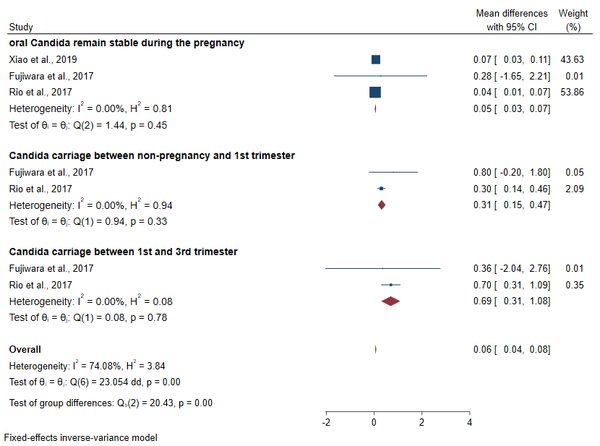-
Home
-
About JCTR
-
Gold Open Access
-
Issues
-
Editorial board
-
Author guidelines
-
Publication fees
-
Online first
-
Special issues
-
News
-
Publication ethics
-
Partners
-
Submit your manuscript
-
Submit your review report
-
Editorial Office
-

This work is licensed under a Creative Commons Attribution-NonCommercial 4.0 International License. ISSN print: 2382-6533 ISSN online: 2424-810X
Volume 9 Issue 3
Evaluation of the periodontal disease on oral microorganisms during pregnancy: a systematic review and meta-analysis
Anahita Shahi, Setareh Khosravi, Farnaz Rezvan, Ali Salehi, Mozhdeh Bourbourshirazi Mahmoudi, Ali Amiri*
Shahi et al. J Clin Transl Res 2023; 9(3):1
Published online: April 15, 2023
Abstract
Background and aim: In the present study, the potential changes of oral microbes during pregnancy were investigated by examining the findings of previous studies and comprehensively examining their results. The relationship between oral microorganisms and birth outcomes and adverse labor outcomes was investigated; to provide sufficient evidence. The purpose of the present study was to evaluate periodontal disease in oral microorganisms during pregnancy.
Materials and methods: All articles were published between January 2011 and January 2023 in international databases, including PubMed, Scopus, Science Direct, and Embase. In order to answer the research questions, the Google Scholar search engine employed the PECO strategy. STATA.V17 software was used to analyze the data.
Results: 218 studies were found in the initial search; 63 full texts were reviewed; and finally, 14 articles were included in the analysis. The mean differences in salivary S. mutans carriage before and after prenatal dental treatment was 0.92 (MD; 95 CI (0.57, 1.27), p>0.05). The odds ratio of association between perinatal mortality and periodontal treatment was -0.88 (OR; 95 CI (-2.53, 0.76), p>0.05) and the odds ratio of association between preterm birth and periodontal treatment was -0.31 (OR; 95 CI (-0.70, 0.09), p>0.05). There was a statistically significant relationship between birth weight and periodontal treatment during pregnancy.
Conclusion: According to the present meta-analysis, periodontal treatment can reduce the odds ratio of perinatal mortality and preterm birth by 88% and 31%, respectively. high association of microorganisms between pregnancy and postpartum requires further study.
Relevance for patients: In the findings of the present study, it is observed that during pregnancy, there is a direct relationship between periodontal disease with low birth weight, perinatal mortality, and preterm delivery; however, the high association of microorganisms between pregnancy and postpartum requires further study. Oral microforms are reported to be affected in pregnant women, and they should take extra care of their mouth and teeth. Sufficient and strong evidence can help improve the health outcomes of mothers and children.

DOI: http://dx.doi.org/10.18053/jctres.09.202303.001
Author affiliation
1. Department of Periodontics, School of Dentistry, Semnan University of Medical Sciences, Semnan, Iran
2. Department of Orthodontics, School of Dentistry, Alborz University of Medical Sciences, Karaj, Iran
3. Faculty of Dentistry, Kurdistan University of Medical Sciences, Sanandaj, Iran
4. Department of Oral and Maxillofacial Radiology, School of Dentistry, Islamic Azad University, Isfahan (Khorasgan) Branch, Isfahan, Iran
5. Department of Periodontics, School of Dentistry, Islamic Azad University, Isfahan (Khorasgan) Branch, Isfahan, Iran
6. Department of Orthodontics, College of Stomatology, The First Affiliated Stomatological Hospital, Xi’an Jiaotong University, Xi’an, PR China
*Corresponding author
Ali Amiri
Department of Orthodontics, College of Stomatology, The First Affiliated Stomatological Hospital, Xi’an Jiaotong University, Xi’an, PR China.
Tel: +86 298 265 5450
Email: draliamiri2020@gmail.com; aliamiri@stu.xjtu.edu.cn
Handling editor:
Michal Heger
Department of Pharmaceutics, Utrecht University, the Netherlands
Department of Chemistry, Utrecht University, Utrecht, the Netherlands
Department of Pathology, Erasmus Medical Center, the Netherlands
Department of Pharmaceutics, Jiaxing University Medical College, Zhejiang, China

